 By Louise Brinck Harrington November 08, 2004
A good idea but it didn't work that way. 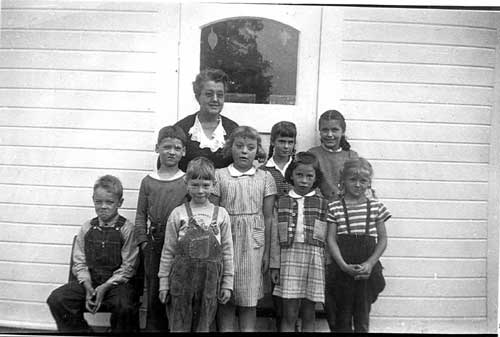 Courtesy of Judy Lemke McCune.
Built in 1947 the school still stands in its original location on Potter Road-a small white wooden structure that looks weathered and worn after years of wear. Yet former students say they have fond memories of the place, memories that go back to the 1940s and 50s when people worked hard and pulled together for the good of the community. It was a time of simple living, before the modern conveniences (distractions, more like?) of electricity or telephones or television. Take for example former student Snapper Carson, who attended the school for six years and says just walking into the schoolroom transports him back to first grade. Carson's favorite school subject was art and he looked forward to drawing and painting and one particular project he calls "making our own movies." The movie-making project required little in the way of materials-a cardboard box, an old broom handle and a roll of newsprint. 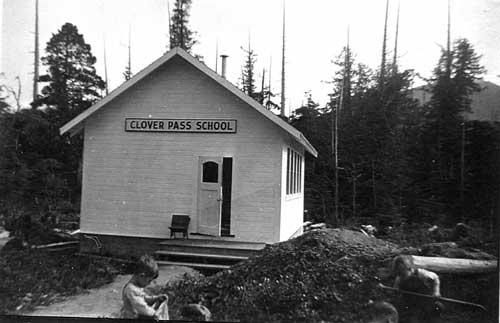 Courtesy of Judy Lemke McCune.
Former student Yvonna (McCombs) Christensen also recalls the "scroll box productions," particularly one that told the story of Bambi. Christensen's cousin, former student Gerald Lemke, still has one of the scrolls, which Lemke describes as "old and fragile"- though it appears to illustrate the story as well as any Walt Disney movie! (Click here to view the "Scroll Box Production" photographs.) Talk about kids making their own entertainment, says Carson. "You had to use your imagination a lot but we were good at that in those days." It was fun, he says, and much more creative than watching TV or playing computer games! 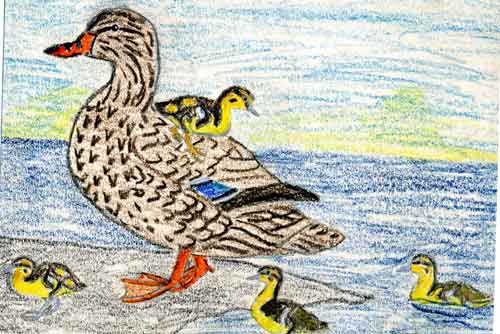
In the 1940s, several local families moved to Clover Pass and took up home sites in the area. At that time, said longtime resident Merta Kiffer in a 1993 oral history interview, the land belonged to the Tongass National Forest and people paid a small fee to the Forest Service, which then allowed them to build on five-acre pieces of property. This was called the Federal Home-site Program. By 1947 "there were enough families with children at Clover Pass to qualify for a small school," Kiffer said, adding that if a school could be built "the children at least wouldn't have to hike up to the highway and take that long bus ride into town." Back then the narrow dirt "highway" to town was rutted and dangerous and nothing like the North Tongass Highway we know today. The Clover Pass families got together and petitioned the territory's Independent School District to provide a teacher, said the late Oral Freeman, another longtime Clover Pass resident speaking in a 1993 interview. The Independent School District agreed to pay for a teacher and school supplies if the community would build the schoolhouse. "And so we did," said Freeman. "We built the Clover Pass School." 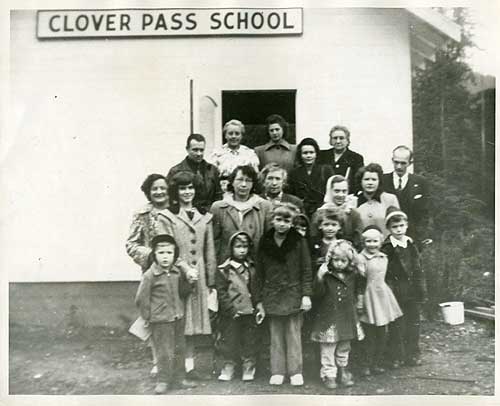 Courtesy of Yvonna McCombs Christensen.
In addition to McCombs and Freeman, several other men helped build the school-Henry and Bill Lemke, Fay Bullock, Kit Carson, Cleo Hall and Ken Kiffer. (There may have been others.) A lot of social life revolved around the building of the school. Snapper Carson's older sister Mary (Carson) Cozens recalls that Trella Bailey, a longtime Clover Pass resident (and mother of Fay Bullock) who lived just north of the school, served large luncheons for the workers and families. Other neighborhood women took turns providing food, running errands, holding bake sales and raffles. A 1947 "Clover Pass Briefs" column in the Ketchikan Daily News tells about the raffles, which were sponsored by the Clover Pass Workers Group. One raffle was for a "Bendix washing machine" and another for a 14-foot Reinell boat. 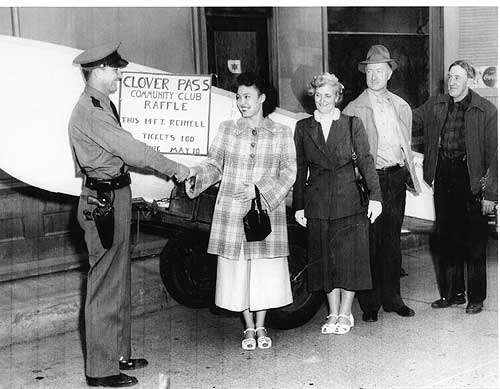
Former student Ron Lemke (known in his younger days as Bruce) remembers the actual building of the school and raising of the flagpole. Again Trella Bailey helped out, this time by donating a flag, and "Mr. H. McKinstry and Charles Potter are preparing a large flagpole with pulleys to be placed in the school yard," says the Clover Pass column. Lemke adds that Potter Road resident Fay Bullock helped raise the pole and everyone appreciated Bullock's assistance because he was a "stout husky guy." "I get a kick out of it when I think of it today," said Freeman in 1993. "We had one room, eight grades, two outhouses, and one teacher. Our oldest son Chuck went to his first two years there. Like anything else, the kids found fun and mischief to get into." 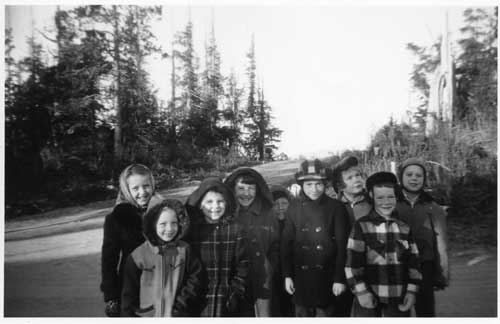 Snapper Carson, Jerry Kiffer and Rodney Johnson. Courtesy of Snapper Carson.
And what kind of mischief might that be? Well, actually not too many former students would talk about it. Freeman's son Chuck told the Ketchikan Daily News in 1990 that surrounding the school "were acres and acres of woods, and the kids used to hide axes and nails in the woods and build forts during recess time." (We can only imagine what else they did!) Former student Sharon (Johnstone) Robertson also remembers recesses and playing "king of the stump." And what was that? Well, "the king of the stump" was the kid who could stand on a big stump the longest without being pulled or pushed off by other students! Snapper Carson says it was cats that got him in trouble. Carson and his friends liked to keep stray cats hidden under a stump behind the school and would bring canned milk from home to feed them. But one day one of the cats had kittens and the teacher found out and that was the end of harboring of hungry kitties at Clover Pass School! Carson also recalls there was a hill across the road and a playground in front of the school "and that's where I learned to ride my bike." Carson and his friends soon figured out that they could come whizzing down the hill, head straight for the playground and grab onto the monkey bars. This was great fun! They would hold onto the monkey bars for dear life and let the bikes go flying into the woods. 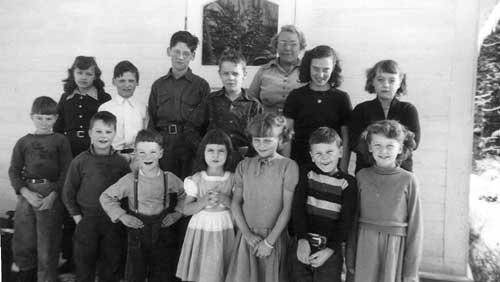 front row, left to right: Ken Kiffer, Rodney Johnson, Jerry Kiffer, Betty Murley, JoAnne Lemke, Snapper Carson, Sharon Lemke. Photo courtesy of Snapper Carson.
Well, okay, so "mischief" in those days was different, nothing like the serious stuff kids can get into today. Memories: Good and Bad Speaking of the teacher, former student Gerald Lemke, now of Yoskarola, Russia, to this day expresses admiration for Mrs. Borigo, the school's first instructor. Mrs. Borigo had to teach all eight grades at once and even as a kid Lemke realized the job was tough and not easy for her. "Can you imagine the lesson plans?" he asks. Sharon (Johnstone) Robertson also remembers feeling sorry for the teacher, though not Mrs. Borigo but Mrs. Wilson, who arrived after Borigo and who worked so hard she often fell asleep in class. Mrs. Wilson had the kids well trained though, says Robertson. "We knew we had to keep quiet while she was taking her nap." Several former students recall that the teacher - both Mrs. Borigo and Mrs.Wilson - often enlisted older students to help teach the younger ones. Jeannette Richardson specifically recalls that Mrs. Wilson would arrange the classroom "with the little kids in front and the big kids in back" for this reason. The students didn't always have an easy time of it either; some of them, in fact, had to go to school on Saturdays. This was actually by choice, says Gerald Lemke, who like many other Clover Pass kids grew up in a fishing family. The Lemkes and others went to school on weekends for months, says Lemke, "so we could get out early and go on the boat during the fishing season." Sometimes on those cold frosty Saturday mornings when students needed an extra boost, Fritz Jensen, who lived across the road from the school, stirred up "genuine homemade sourdough pancakes." To this day Gerald's younger brother Ron Lemke remembers those delicious pancakes, "which were made with sourdough starter that Jensen kept stored in his pantry." What a way to start the day! 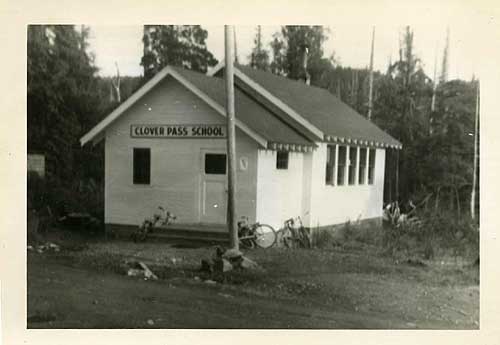 Courtesy of Yvonna McCombs Christensen.
Joanne (Lemke) Delys, who currently lives in New Mexico, has school-day memories different from her brothers. She remembers funny things such as the outhouse, which she describes as a "three-holer" design. She also recalls fun activities like "double Dutch jump roping" during recess and a "Maypole Day" ceremony in the spring. There's another funny "Lemke story" that none of the family will own up to, at least in public. The tale appears here as told by one of the younger Lemkes who didn't attend the school but heard the story over and over: It seems that one anonymous Lemke student spent a lot of time "day dreaming." One day this student suddenly woke up and realized the teacher had asked him to do something. But what was it? He got up, walked over to the lantern and lit it, hoping that was what the teacher wanted. But, no, what the teacher had asked him to do was to turn on the radio to get ready for a special school broadcast. This of course caused a good laugh both at the time and whenever the story was retold over the years! And then there's former student Bruce Johnstone, who recalls being in the seventh grade at Clover Pass School and proud to be the "only seventh grade student on the honor roll." This was around 1957 and a big accomplishment for Johnstone, especially since he was the one and only seventh grade student in the school that year! On the other hand Marian (Woolery) Glenz doesn't remember much that was fun about the school. She doesn't really remember much of anything, she says, except how homesick she was. The rest of the Woolery family lived at Port Protection on Prince of Wales Island, where Marian's dad (well-known "Buckshot" Woolery) ran a fish-buying business. There was no school at Port Protection so young Marian was sent to Ketchikan to board with other families. At various times she lived with both the Lemke and Carson families at Knudsen Cove. 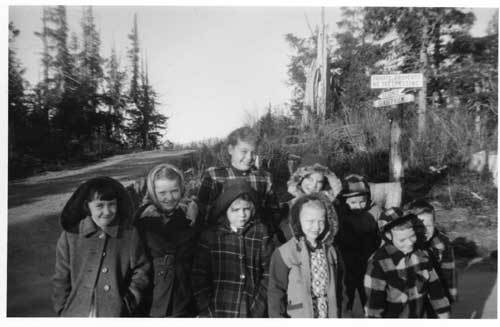 Courtesy of Snapper Carson
Terry Richardson, of Ketchikan, started going to Clover Pass School when he was five years old, probably one of the youngest students to attend. This was in the school's later years, around 1960, when Richardson's family lived near the present Clover Pass Resort-which meant the boy had a two-mile trek ("uphill each way," Richardson says with a chuckle) to school and back. Usually his older sister Jeannette walked with him, which was good: In the spring and fall, the two wary students took careful note of hungry bears scavenging in the woods for roots and berries! And then in the winter the
Richardson kids had to worry about snowplows. "One day a
snowplow came along the old highway [now Knudsen Cove Road] and
blew me in the ditch," recalls Richardson, who apparently
was unfazed by the incident. He picked himself up, climbed back
up on the road and kept walking. Declamation Contests, Janitor Jobs and the Simple Life The school held annual "Declamation Contests," during which each student stood up and recited a poem he or she had memorized. Over time, the contests became popular with parents who would stop by and listen to their children perform. One day Ketchikan School Superintendent Danielson even showed up and "judged one such performance, giving out appropriate ribbons," recalls Yvonna Christensen. 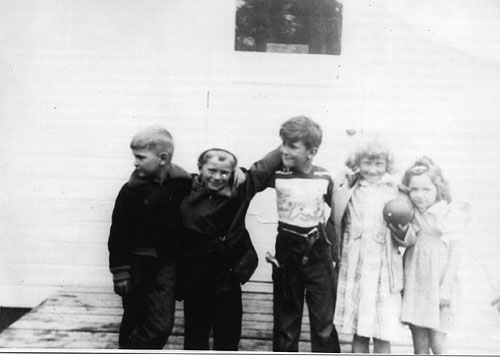 Courtesy of Yvonna McCombs Christensen.
As Snapper Carson grew older, he and his younger brother Harold were hired as school janitors. "We had to get to school early in the morning before the teacher and fill up the gas lanterns and kerosene lamps and get them all going," says Carson. This was in the days before electricity at Clover Pass and the boys had to trim the wicks, pump up and light the lamps, and get everything ready for the school day. Carson thinks he and Harold together earned $20 a month. "But can you imagine?" Carson asks today. "Giving that kind of responsibility to a kid? The government wouldn't allow that now." But back then people did what they had to do, he says. They did what they had to do to survive. It was a simpler way of life. "Everything was simpler then," agrees Ron Lemke. "Everyone knew everyone else and there was that sense of community." People helped each other. "Those in the community who built that school did a really great job," Lemke continues. "We were all proud of it when we started going to school there." With such community spirit it only makes sense that when the time came to close the school, Clover Pass residents put up a fight. But it was a losing battle: The school was closed in 1961. Historic Ketchikan now has
title to the Clover Pass School building (but not the land, which
is another story for another time) and plans to hold more
work parties in the future. Hopefully more memories will be forthcoming
and someone will be there to record them for posterity
and work on that book!
|